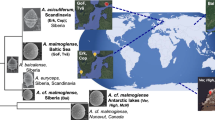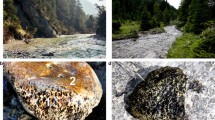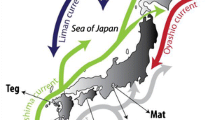Abstract
The extent to which free-living microorganisms exist in geographically isolated, genetically distinct populations is a subject of continuing debate. Some authorities contend that many microorganisms have cosmopolitan distributions, while others provide evidence that more limited geographical distribution of genetically distinct populations can occur. We report the occurrence of two morphologically similar, but genetically distinct, populations of the microbial eukaryote Peridinium limbatum (Stokes) Lemmermann from neighboring Northern Wisconsin freshwater bodies. Five strains of P. limbatum were cultured by single-cell isolation from both Crystal Lake and Crystal Bog (Oneida Co., WI). Genetic variation between the two populations encompassed 8.9% (mean of 35.4 of 397 nucleotides) of the nuclear ribosomal DNA internal transcribed spacer (ITS1 and ITS2) region. In contrast, 0.5% (mean of 2.25 of 397 nucleotides) variation was observed within the Crystal Lake population and 0.3% (mean of 1.21 of 397 nucleotides), within the Crystal Bog population. This difference between the two populations was highly statistically significant (p-value << 0.001). The extent of genetic variation between the two P. limbatum populations was greater than that reported in the literature for some morphologically distinguishable microalgal species, suggesting the occurrence of cryptic sister species. On the other hand, hybrid sequences obtained from one of the Crystal Lake strains suggest that the two populations may still be members of a single sexually compatible biological species. Our data suggest that the two neighboring P. limbatum populations may be diverging genetically under conditions of limited gene flow, suggesting a mechanism for the origin of geographically isolated, genetically distinct populations of microbial eukaryotes.




Similar content being viewed by others
References
JF Aguilar JA Rossello N Feliner (1999) ArticleTitleNuclear ribosomal DNA (nrDNA) concerted evolution in natural and artificial hybrids of Armeria (Plumbaginaceae). Mol Ecol 8 1341–1346 Occurrence Handle10.1046/j.1365-294X.1999.00690.x Occurrence Handle10447874
LGM Baas-Becking (1934) Geobiologie of inleiding tot de milieukunde Van Stockum WP & Zoon NV The Hague, The Netherlands
BJ Finlay (2002) ArticleTitleGlobal dispersal of free-living microbial eukaryote species. Science 296 1061–1063 Occurrence Handle10.1126/science.1070710 Occurrence Handle1:CAS:528:DC%2BD38Xjslagsb0%3D Occurrence Handle12004115
BJ Finlay GF Esteban JL Olmo PA Tyler (1999) ArticleTitleGlobal distribution of free-living microbial species. Ecography 22 138–144
JM Graham AD Kent GH Lauster AC Yannarell LE Graham TK Kratz EW Triplett (2004) ArticleTitleSeasonal dynamics of phytoplankton and planktonic protozoan communities in a northern temperate humic lake: diversity in a dinoflagellate dominated system. Microb Ecol 48(4) in press
Graham, LE, Wilcox, LW (2000) Algae. Prentice-Hall, Upper Saddle Rivers, NJ
Lee, JJ, Leedale, GF, Bradbury, P (Eds.) (2000)The Illustrated Guide to the Protozoa, 2nd ed., Society of Protozoologists, Lawrence, KS
JT Lehman (1976) ArticleTitleEcological and nutritional studies on Dinobryon Ehrenb: seasonal periodicity and the phosphate toxicity problem. Limnol Oceanogr 21 646–658 Occurrence Handle1:CAS:528:DyaE28XlsFKhtbw%3D
DR Maddison WP Maddison (2001) MacClade 4: Analysis of Phylogeny and Character Evolution, Version 4.03 Sinauer Associates Sunderland, MA
LK Medlin M Lang A Larsen (2000) Cosmopolitan haptophyte flagellates and their genetic links. BSC Leadbeater JC Green (Eds) The Flagellates Taylor & Francis London 288–308
M Montresor S Sgrosso G Procaccini WHCE Kooistra (2003) ArticleTitleIntraspecific diversity in Scrippsiella trochoidea (Dinophyceae): evidence for cryptic species. Phycologia 42 56–70
North Temperate Lakes Long Term Ecological Research. Jan 21, 2004 Center for Limnology UW-Madison Dec 8, 2003 (http://lter.limnology.wisc.edu/index.html)
RT Papke NB Ramsing MM Bateson DM Ward (2003) ArticleTitleGeographical isolation in hot spring cyanobacteria. Environ Microbiol 5 650–659 Occurrence Handle10.1046/j.1462-2920.2003.00460.x Occurrence Handle1:CAS:528:DC%2BD3sXntFyqsbc%3D Occurrence Handle12871232
DJ Patterson WJ Lee (2000) Geographic distribution and diversity of free living heterotrophic flagellates. BSC Leadbeater JC Green (Eds) The Flagellates Taylor & Francis London 269–287
JR Stein (Eds) (1973) Handbook of Phycological Methods: Culture Methods and Growth Measurements The Press Syndics of the University of Cambridge New York
DL Swofford (2002) PAUP*. Phylogenetic Analysis Using Parsimony (*and Other Methods), Version 4 Sinauer Associates Sunderland, MA
EJ Van Hannen M Lurling E Van Donk (2000) ArticleTitleSequence analysis of the ITS-2 region: a tool to identify strains of Scenedesmus (Chlorophyceae). J Phycol 36 605–607 Occurrence Handle10.1046/j.1529-8817.2000.99190.x Occurrence Handle1:CAS:528:DC%2BD3cXmslart78%3D
GC Wang Y Wang (1997) ArticleTitleFrequency of formation of chimeric molecules as a consequence of PCR coamplification of 16S rRNA genes from mixed bacterial genomes. App Environ Microbiol 63 4645–4650 Occurrence Handle1:CAS:528:DyaK2sXnvV2rsbw%3D
RJ Whitaker DW Grogan JW Taylor (2003) ArticleTitleGeographic barriers isolate endemic populations of hyperthermophilic Archaea. Science 301 976–978 Occurrence Handle10.1126/science.1086909 Occurrence Handle1:CAS:528:DC%2BD3sXmt1elsLc%3D Occurrence Handle12881573
Acknowledgments
This research was supported by grant MCB-9977903 from the National Science Foundation. We thank Phil Oshel at the University of Wisconsin—Madison Animal Sciences Microscopy Labs for assistance with scanning electron microscopy.
Author information
Authors and Affiliations
Corresponding author
Rights and permissions
About this article
Cite this article
Kim, E., Wilcox, L., Graham, L. et al. Genetically Distinct Populations of the Dinoflagellate Peridinium limbatum in Neighboring Northern Wisconsin Lakes. Microb Ecol 48, 521–527 (2004). https://doi.org/10.1007/s00248-004-0219-z
Received:
Accepted:
Published:
Issue Date:
DOI: https://doi.org/10.1007/s00248-004-0219-z




